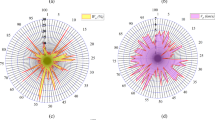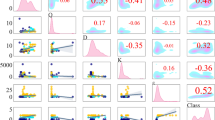Abstract
Large-scale and time-consuming testing is required to establish the rock’s capillary water absorption (\({\text{CWA}}\)); however, predictive technologies may lessen these needs. In this study, the hybrid support vector regression (\({\rm SVR}\)) analysis was developed to predict the \({\rm CWA}\) of the building stones. \({\rm SVR}\)’s great performance depends on determining the main parameters of it, where for this aim, two optimization algorithms were considered named arithmetic optimization algorithm (\({ {\rm AOA}}\)) and sine–cosine algorithm (\({ {\rm SCA}}\)). The mentioned hybrid regression analysis has not been developed for predicting the \({\rm CWA}\) of building rock so far, which makes this study to be innovative. During the train and test rounds, there was a strong correlation between the observed and predicted \({\rm CWA}\) s, with \(R^{2}\) values of 0.9668 and 0.9497, respectively. \({\rm AOA} - {\rm SVR}\) may receive less data than \({\rm SCA} - {\rm SVR}\) network by decreasing from 24.478 to 21.759 \({\text{g}}/{\text{m}}^{2} /{\text{s}}^{0.5}\) in the train round and from 22.52 to 18.87 \({\text{g}}/{\text{m}}^{2} /{\text{s}}^{0.5}\) in the test round when using the root mean squared error (\({\rm RMSE}\)) measure. The performance index (\(PI\)) shows that the \({\rm AOA} - {\rm SVR}\) system's capacity to represent lower values than \({\rm SCA} - {\rm SVR}\), with train round values of 0.1554 lower than 0.1751 and test round values of 0.1892 lower than 0.227. In comparison with the earlier study, the coefficient of determination (\(R^{2}\)) values increased from 0.708 (multiple linear regression) to 0.9745 (\({\rm AOA} - {\rm SVR}\)), demonstrating a considerable improvement in workability. The created \({\rm AOA} - {\rm SVR}\) method may be called the outperformed approach since it can determine the \({\rm CWA}\) of building stones.








Similar content being viewed by others
References
Abualigah L, Diabat A, Mirjalili S, Abd Elaziz M, Gandomi AH (2021) The arithmetic optimization algorithm. Comput Methods Appl Mech Eng 376:113609. https://doi.org/10.1016/j.cma.2020.113609
Aghayari Hir M, Zaheri M, Rahimzadeh N (2022) Prediction of rural travel demand by spatial regression and artificial neural network methods (Tabriz County). J Transport Res.
Benavente D, Martínez-Martínez J, Algozzini G, García Del Cura MA (2006) Influence of water transport and pore structure on the durability of porous building stones. In: The 10th IAEG International Congress, Nottingham, United Kingdom, pp. 6–10
Benemaran RS (2023) Application of Extreme gradient boosting method for evaluating the properties of episodic failure of borehole breakout. Geoenergy Sci Eng:211837
Benemaran RS, Esmaeili-Falak M (2020) Optimization of cost and mechanical properties of concrete with admixtures using MARS and PSO. Comput Conc 26(4):309–16. https://doi.org/10.12989/cac.2020.26.4.309
Borelli (1999) Porosity-conservation of architectural heritage-historic structures and materials. ARC Laboratory Handbook, ICCROM, Rome, pp. 1–32
Çobanoğlu İ (2015) Prediction and identification of capillary water absorption capacity of travertine dimension stone. Arab J Geosci 8(11):10135–10149
Cultrone G, Sebastián E, Elert K, La Torre MJ, De Cazalla O, Rodriguez-Navarro C (2004) Influence of mineralogy and firing temperature on the porosity of bricks. J Eur Ceram Soc 24(3):547–64
Dinçer İ, Özvan A, Mutluhan A, Tapan M, Vural O (2012) İgnimbiritlerin Kapiler Su Emme Potansiyellerinin Değerlendirilmesi: Ahlat Taşı Örneği. Yüzüncü Yıl Üniversitesi Fen Bilimleri Enstitüsü Dergisi 17(2):64–71
En-1925 (2000) T. S., Natural Stone Test Methods Determination of Water Absorption Coefficient by Capillarity, Turkish Standards Institution, Ankara
Erguler ZA (2009) Field-based experimental determination of the weathering rates of the cappadocian tuffs. Eng Geol 105(3–4):186–199
Esmaeili Falak M, Sarkhani Benemaran R (2022) Investigating the stress-strain behavior of frozen clay using triaxial test. J Struct Construct Eng
Esmaeili‐Falak M, Sarkhani Benemaran R (2023) Ensemble deep learning-based models to predict the resilient modulus of modified base materials subjected to wet-dry cycles. Geomech Eng 32(6): 583–600. https://doi.org/10.12989/gae.2023.32.6.583
Esmaeili-Falak M, Katebi H, Javadi A (2018) Experimental study of the mechanical behavior of frozen soils-a case study of tabriz subway. Period Polytech Civil Eng 62(1):117–125. https://doi.org/10.3311/PPci.10960
Esmaeili-Falak M, Katebi H, Vadiati M, Adamowski J (2019) Predicting triaxial compressive strength and young’s modulus of frozen sand using artificial intelligence methods. J Cold Reg Eng 33(3):4019007. https://doi.org/10.1061/(ASCE)CR.1943-5495.0000188
Ge D-M, Zhao L-C, Esmaeili-Falak M (2022) Estimation of rapid chloride permeability of SCC using hyperparameters optimized random forest models. J Sustain Cem Based Mater:1–19
İnce İ, Bozdağ A, Barstuğan M, Fener M (2021) Evaluation of the relationship between the physical properties and capillary water absorption values of building stones by regression analysis and artificial neural networks. J Build Eng 42:103055
Ioannou I, Andreou A, Tsikouras B, Hatzipanagiotou K (2009) Application of the sharp front model to capillary absorption in a vuggy limestone. Eng Geol 105(1–2):20–23
Melo MJ, Bracci S, Camaiti M, Chiantore O, Piacenti F (1999) Photodegradation of acrylic resins used in the conservation of stone. Polym Degrad Stab 66(1):23–30
Mirjalili S (2016) {\rm SCA}: a sine cosine algorithm for solving optimization problems. Knowl Based Syst 96:120–133. https://doi.org/10.1016/j.knosys.2015.12.022
Ozdemir A (2002) Bazı Yapi malzemelerin kapiler su emme potansiyelleri (in Turkish). Geol Eng J 26(1):19–32
Poli T, Toniolo L, Chiantore O (2004) The protection of different italian marbles with two partially flourinated acrylic copolymers. Appl Phys A 79(2):347–351
Premkumar M, Jangir P, Kumar BS, Sowmya R, Alhelou HH, Abualigah L, Yildiz AR, Mirjalili S (2021) A new arithmetic optimization algorithm for solving real-world multiobjective CEC-2021 constrained optimization problems: diversity analysis and validations. IEEE Access 9:84263–84295
Qian D, Yang J, Wang J (2022) Novel hybrid models to predict the capillary water absorption values of building stones. Eng Res Express
Sengun N, Demirdag S, Akbay D, Ugur I, Altindag R, Akbulut A (2014) Investigation of the relationships between capillary water absorption coefficients and other rock properties of some natural stones, V. Global Stone Cong: 22–25
Shi X, Yu X, Esmaeili-Falak M (2022) Improved arithmetic optimization algorithm and its application to carbon fiber reinforced polymer-steel bond strength estimation. Compos Struct:116599
Sousa LMO, del Río LMS, Calleja L, de Argandona VGR, Rey AR (2005) Influence of microfractures and porosity on the physico-mechanical properties and weathering of ornamental granites. Eng Geol 77(1–2):153–168
Vázquez P, Alonso FJ, Esbert RM, Ordaz J (2010) Ornamental granites: relationships between p-waves velocity, water capillary absorption and the crack network. Constr Build Mater 24(12):2536–2541
Yang C, Feng H, Esmaeili-Falak M (2022) Predicting the compressive strength of modified recycled aggregate concrete. Struct Conc
Yuan J, Zhao M, Esmaeili‐Falak M (2022) A comparative study on predicting the rapid chloride permeability of self‐compacting concrete using meta‐heuristic algorithm and artificial intelligence techniques. Struct Conc
Zhao G, Wang H, Li Z (2022) Capillary water absorption values estimation of building stones by ensembled and hybrid SVR models. J Intell Fuzzy Syst:1–13
Zhu W, Huang L, Mao L, Esmaeili‐Falak M (2022) Predicting the uniaxial compressive strength of oil palm shell lightweight aggregate concrete using artificial intelligence‐based algorithms. Struct Conc. From https://onlinelibrary.wiley.com/doi/10.1002/suco.202100656.
Author information
Authors and Affiliations
Contributions
BY: was involed in project administration, language review, and supervision. YW: contributed to conceptualization, methodology, and software.
Corresponding author
Ethics declarations
Conflict of interest
The authors declare no competing interests.
Additional information
Publisher's Note
Springer Nature remains neutral with regard to jurisdictional claims in published maps and institutional affiliations.
Rights and permissions
Springer Nature or its licensor (e.g. a society or other partner) holds exclusive rights to this article under a publishing agreement with the author(s) or other rightsholder(s); author self-archiving of the accepted manuscript version of this article is solely governed by the terms of such publishing agreement and applicable law.
About this article
Cite this article
Yu, B., Wei, Y. A comparison study of regression analysis for estimating the capillary water absorption of construction stones. Multiscale and Multidiscip. Model. Exp. and Des. 6, 685–696 (2023). https://doi.org/10.1007/s41939-023-00168-7
Received:
Accepted:
Published:
Issue Date:
DOI: https://doi.org/10.1007/s41939-023-00168-7




